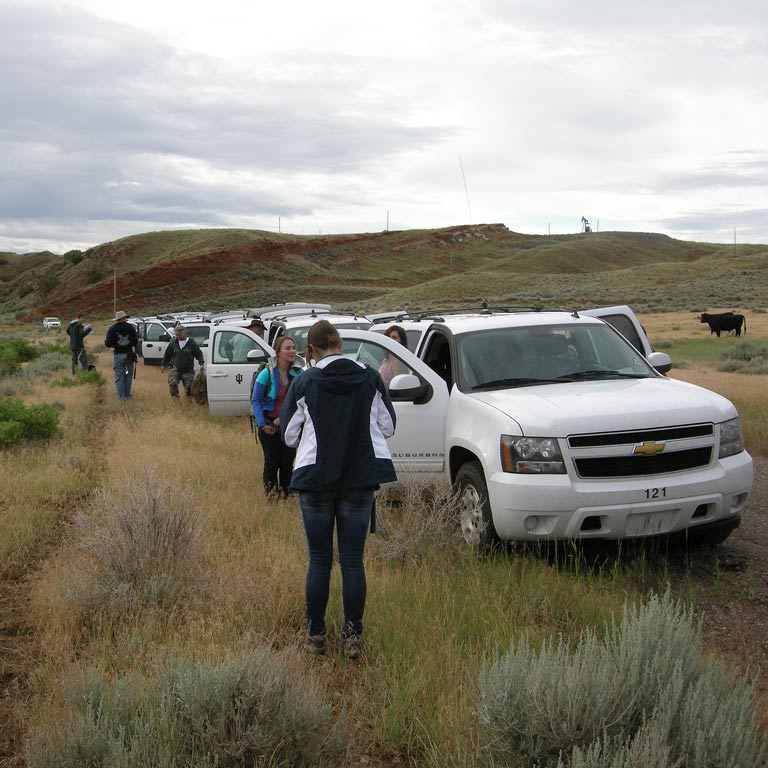- Location
- IU Judson Mead Field Station, Cardwell Montana
- Days and Times
- June 10 - July 23
- Course Description
EAS X429 - Field Geology in the Rocky Mountains (June 10 - July 23, 2024) is our capstone course designed to prepare students to be successful in a geoscience career and/or geoscience graduate school program. This course focuses on the integration of geology, geochemistry and geophysics to solve 4-dimensional geoscience problems. X429 includes both a 1-week thesis style project and a deep-dive into a subdiscipline concentration of your choosing (see EAS X498 descriptions below).
EAS X429 is an immersive, hands-on, field geology course designed to allow you to build and integrate a diverse set of geoscience skills to solve 4-dimensional geologic problems from outcrop to regional scale.
EAS X429 utilizes three primary learning techniques.
- Detailed field instruction, typically with a 7:1 or better student-to-faculty ratio. The standard week includes two days of detailed field instruction in one or more of the following:
- Describing rocks and measuring geologic attributes in the field;
- Detailed descriptions of sedimentary rocks and measurement of stratigraphic sections;
- Mapping and analyzing geologic structures;
- Geologic cross section construction and interpretation of a complex geologic history;
- Field studies of igneous and metamorphic rocks including cross-cutting relationships, compositional observations, and basic interpretation of pressure, temperature and depth conditions;
- Reconnaissance scale mapping of a large, geologically complex area.
- Followed by three days of applying these skills to a solve a problem.
- A major, thesis style project – a 1-week geologic mapping, analysis, and interpretation project for a relatively large area with significant geologic diversity and complexity. Each student works quasi-independently to produce a report including geologic maps, geologic cross sections, relevant data and analyses, an interpretation of the geologic history, and an explanation about how it fits into the regional geologic context.
- Field exams - Students work independently during ~6-hour long field exams collecting basic observational data, constructing a geologic map and cross sections, and interpreting the geologic history of an area they have not previously visited. All materials are turned in prior to a debrief on the geology before leaving the field area. There are three or four field exams during the course.
In a typical year, EAS X429 students come from more than 25 different universities. In recognition that not all students have the same background when they start the course, the curriculum is designed to allow students to have more or less faculty interaction depending on their experience, learning needs, and confidence working in the field. EAS X429 grading is back-end weighted, with later projects counting much more than earlier projects.
EAS X429 requires a minimum of two years of a standard undergraduate geoscience curriculum including one introductory course plus at least two courses from the following:
- sedimentology and/or stratigraphy
- mineralogy and/or petrology
- structural geology and/or tectonics
A course in Earth history plus additional topical courses can be beneficial, but are not required.
Students with alternative backgrounds who do not have all of the prerequisites are encouraged to apply and will be considered on a case-by-case basis.
EAS X498 subdiscipline concentrations (June 29 - July 3, 2024) are an integral part of X429 and are also open to students who don’t take X429. We currently offer five field-based subdiscipline concentration subjects. Each course is a 1-credit, 1-week course. All five courses are taught concurrently at IUGFS. Prerequisite for all X498 concentrations – students need to have taken at least three geoscience courses and have some experience describing rocks, taking geologic measurements, and taking notes in the field.
- Detailed field instruction, typically with a 7:1 or better student-to-faculty ratio. The standard week includes two days of detailed field instruction in one or more of the following:
EAS X429 Field Geology in the Rocky Mountains

 The College of Arts
The College of Arts